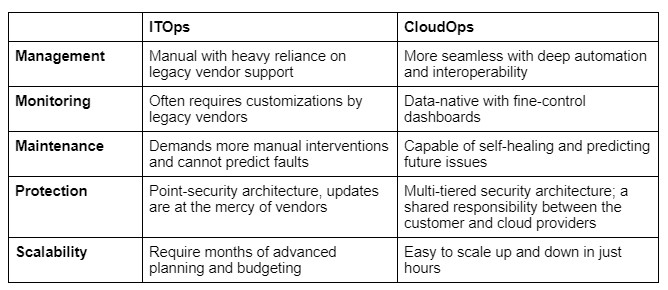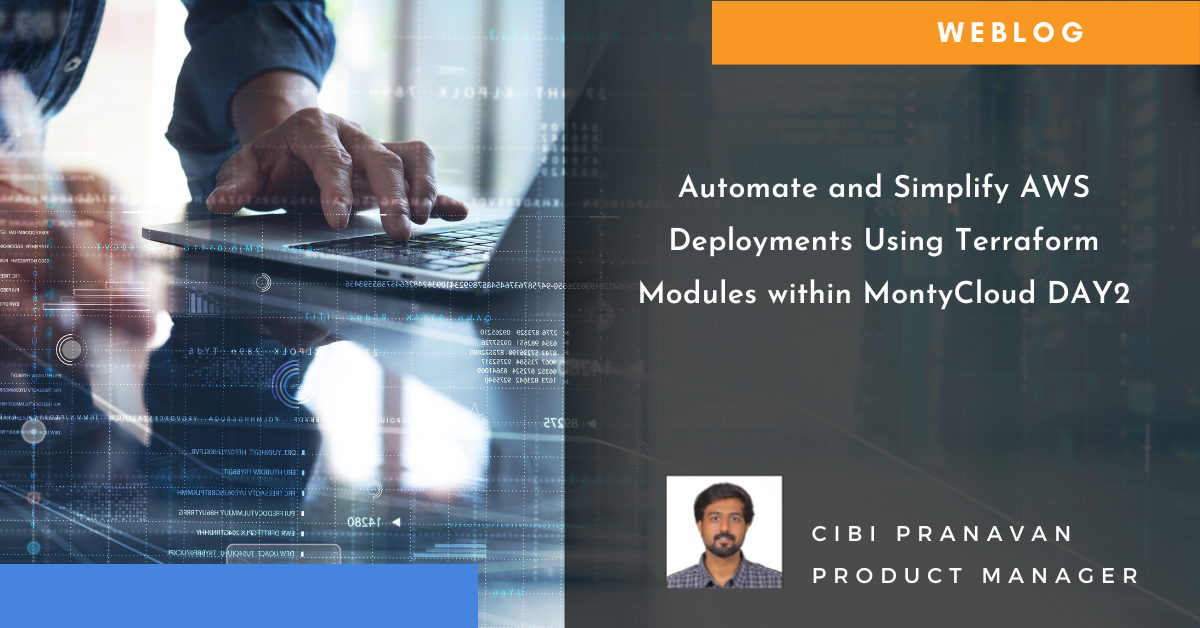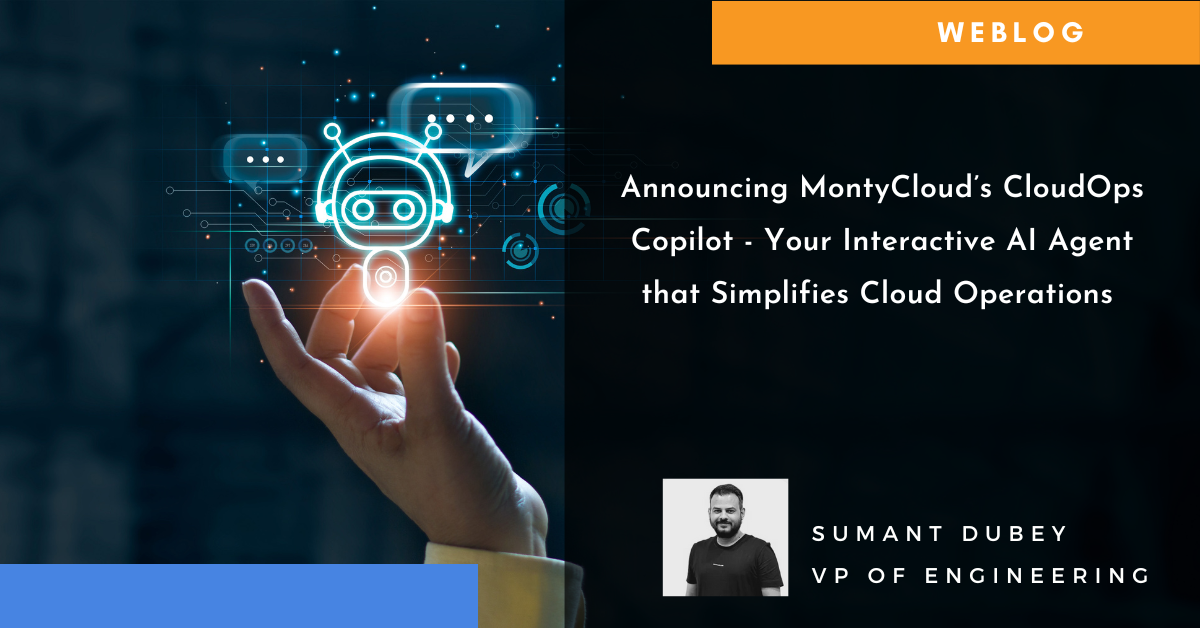MontyCloud DAY2 Automated Resource Tagging for AWS MAP
Have you signed an agreement to begin migrating to AWS? Or are you a Managed Service Provider (MSP) with an AWS Migration Competency delivering AWS...
5 min read
 Sabrinath Rao
:
Dec 17, 2020 11:41:00 AM
Sabrinath Rao
:
Dec 17, 2020 11:41:00 AM
Over the last decade, new technologies have evolved faster than IT teams could adapt their skills.
And new technology tends to bring new terminology – ITOps, CloudOps, AIOps, SecOps, DevOps, BizDevOps, even No Ops.
Do you need to embrace every single concept? Probably not. Does it help to understand what the different terms mean and how they relate to one other? Definitely yes.
I’m not going to define each of these terms again. The team at STXNext has already done a solid job of defining most of them and of comparing and contrasting ITOps with DevOps.
I’ll focus on the two terms that are used most commonly – ITOps and CloudOps. Some people use them interchangeably, but in practice ITOps and CloudOps require very different skills and tools.
IT Operations or ITOps is the entire underlying organization of computer hardware, software, networks, applications, services and security that keeps every other part of the business running and growing. In the past, this used to be all on-premise data-centers and supporting equipment.
Today, a growing number of applications are hosted on and delivered from the cloud. Most large enterprises still use a hybrid model of on-premise and cloud systems. This requires growing use of Cloud Operations or CloudOps along with existing ITOps.
With traditional ITOps, your responsibility was efficient operations in the data-center – hardware, servers, server-room, power-supplies, and so on. And troubleshooting meant often working with hardware servers even using tools; a screwdriver or a wrench.
At large enterprises, ITOps still rely on big internal teams supported by external vendors or partners who understand certain bits of hardware, network and security better, especially when proprietary systems are deployed.
CloudOps, however, is the practice of dealing with how things are deployed, run, and maintained on the cloud and remotely.
With CloudOps you never actually see, touch or have access to the underlying resource such as server, network switch, or the storage devices. You rely on your cloud provider to always have capacity and always keep the service available all the time.
In Well-Managed CloudOps environments, your users deploy applications using pre-approved resources, operate them in compliant & secure environments, and to stay within cost guardrails.
You meanwhile, have the ability to troubleshoot when required.
As you think about migrating to the cloud or scaling up your cloud operations, it is important to understand what you will gain and where things will change.
Here are 5 ways in which Cloud Ops is different from ITOps, and in many ways an improvement on how IT servers, storage, applications and security are managed.

1 – CloudOps uses automation for management & maintenance tasks
With CloudOps it’s logically and operationally straightforward to build layers of automation around your cloud compute instances, infrastructure services and applications by leveraging Infrastructure as Code. This helps you cut down management overhead.
As your IT team runs and manages their applications remotely, they only need to worry about the software and users that connect to these applications.
Of course, cloud companies like AWS, Microsoft Azure do have maintenance staff that take care of server hardware problems. However, those problems are rarely visible to you and don’t really affect your applications. In fact, such downtimes are covered and protected by SLAs of cloud providers. That said, keep in mind, aspects such as security and compliance are shared responsibilities between you and the cloud provider, and they have impact on your resources.
By eliminating hardware and network maintenance overhead in a CloudOps setup, you can focus on setting up automations for tasks. For example regular backups, security checks, patch deployments, access management, application versioning, and more.
2 – CloudOps brings data-driven system monitoring and control
Data is the backbone of successful CloudOps. All metrics and actions in the application environment are measured, logged and can be available to you via dashboards and alerts – often in real-time.
In the cloud, everything is recorded and stored at every step. You can easily look for patterns to optimize your costs and efficiency or perform troubleshooting.
CloudOps makes it easy to oversee and run the entire organization’s technology stack using real-time data and with prediction capabilities. Ultimately, this level of granular control and data-driven monitoring helps IT teams improve the stability of the computing environment.
3 – CloudOps systems are self-healing and low maintenance
You can configure CloudOps platforms typically to automatically identify and resolve many issues without interruptions to end-user experience. This reduces IT downtime to near 0%.
Powerful self-healing features ensure that IT staff’s valuable time is used only for more significant issues. Advanced CloudOps platforms also use AI to learn from past resolutions and keep growing the number of issues they can resolve in the future.
Finally, predictive cloud analytics helps identify problems as they occur and use historical data to predict issues before they happen again. These automated predictions can alert IT teams to possible failures, errors or even security weaknesses.
4 – CloudOps features multi-tiered protection
Securing data and applications in CloudOps is a very different proposition compared to traditional ITOps. As all application data is passed over public networks in cloud computing, existing security practices developed for on-premise environments have evolved.
CloudOps uses several measures split up at different levels to ensure security. For example, centralized monitoring ensures that traffic, malicious content, sensitive data, personal information, vulnerabilities and more are kept under a close eye.
There are also protections on the web application layers that ensure that the software firewalls and virtual private cloud boundaries protect application data across the public network using cloud-based threat detection within the application content.
As the cybersecurity industry adapts to growing use of CloudOps, there are new systems of data and application security hitting the market. And as CloudOps updates can be easily and cheaply made, your security systems are always up to date. This is a key benefit over traditional ITOps where security updates can take months and even years and are at the mercy of legacy vendors.
5 – CloudOps scales to changing demands with metered costs
With ITOps, teams try to balance the growing demand for computing resources with the budgets that are released once a year. It is a game of trying to be as accurate with your forecasts for resource usage as possible without limiting the growth potential of the company. Either you would underinvest in on-premise infrastructure and try to keep things running under constrained resources or you would overinvest leading to idle resources and wastage.
Cloud computing is popular today because CloudOps takes away the burden of budgeting and planning uncertainties. As cloud resources are allocated virtually across an array of distributed servers, in CloudOps your estimates only need to look ahead to the next few days and weeks.
Expecting more usage? Simple, shift up your plan with your cloud provider and they can allocate you more resources in a matter of hours. Macro-trends like the pandemic reducing the demand for computing power? No problem, simply shift-down your cloud plan and weather the storm by saving your budget.
Powerful CloudOps platforms are designed for this. With a centralized interface you can see how and where cloud computing needs are growing or falling and dynamically allocate resources based on changing demand across applications.
AI-powered platforms even go a step further and predict which applications will likely need more resources in the coming weeks so you can even remove the headache of manual forecasting from your plate.
If you are planning to shift or in the middle of shifting your IT infrastructure model from on-premise to cloud, remember, there is no silver bullet. In the near future, most organizations will use a mix of both. If you are a cloud-native team, then you already know this.
IT teams would continue to use their skills in both operations models and get the right tools to make their lives easier while ensuring cutting-edge performance.
I hope this helps you understand where the gains of using both models with the right balance can come from.

Have you signed an agreement to begin migrating to AWS? Or are you a Managed Service Provider (MSP) with an AWS Migration Competency delivering AWS...

The Imperative of Infrastructure as Code (IaC) Just as blueprints are vital for constructing resilient physical infrastructure, Infrastructure as...

Today I am super excited to announce the availability of MontyCloud’s CoPilot for Cloud Operations, an interactive Agent for simplifying Cloud...